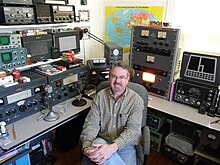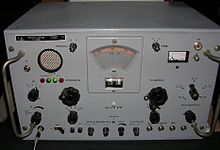Classic amateur radio

Classic amateur radio is an expression of the amateur radio hobby and is based on the device technology and the types of modulation that were common in the period before and after the Second World War until the introduction of digital technologies.
activities
Classic amateur radio includes self-assembly of transmitters and receivers, as well as the restoration, reproduction, preservation and collection of historical devices, often also from the commercial and military sectors. Enthusiasts operate amateur radio traffic with the possibilities of the amateur radio at the time, such as amplitude modulation , radio telex and Morse code telegraphy. This can be seen as maintaining older knowledge and basic skills of the amateur radio hobby.
Essential impulses for this form of amateur radio hobby come from the Anglo-American area, but radio amateurs have already joined forces in France and Holland.
A number of museum stations and museum ships with radio stations that are accessible to licensed radio amateurs are also known. Competitions and diploma tenders that address this aspect of the amateur radio hobby are rarer.
The fascination for involvement in classic amateur radio comes from electron tubes , whose sensuality appeals to many amateurs more than commercially mass- produced devices based on microprocessor and SMD technology. At the same time, there are a large number of classic amateur radio devices whose technical parameters can withstand a comparison with current technology.
Since v. a. senior military equipment by a considerable weight stand out, they are in the jargon of English as a boat anchor or Boat Anchor referred. The mechanically more spacious and clear structure of older technology naturally makes it easier to repair and maintain it, even with simpler amateur means without expensive special equipment.
Amplitude modulation
Amplitude modulation (technically abbreviated AM or standardized A3E) is the original way of transmitting speech in radio communication. This type of modulation, regardless of its advantages and disadvantages, is a specialty in the context of the various forms of amateur radio hobby.
The majority of AM enthusiasts operate stations where the transmitter and receiver are separate devices, as is the case with classic amateur radio. A few also use former, smaller shortwave broadcasters. Stations, so-called homebrew stations, which were built from scratch and built by themselves, as was the norm before the commercial era of amateur radio, are also common.
Classic devices
Classic radio traffic activities are of course not limited to amplitude modulation. Many older devices can also be used for other types of message transmission, especially radio telex (RTTY), telegraphy (CW), frequency modulation (FM) and single sideband modulation (SSB).
The collection area in this context is almost unlimited, often very specialized and includes the product range of many well-known companies all over the world and is thus a contribution to contemporary and technical history on a private initiative. Relevant collectors' fairs are predominantly associated with sales fairs for modern hobby electronics.
Self-made
Simple, do-it-yourself devices with classic circuits tie in particularly with the era of amateur radio between 1920 and 1930, when practically everything was self-made in home work. Even today, beautiful-looking small devices with simple but functional technology are still being created. There is also a competition for this.
A variant of this is the combination with QRP operation, in which transmission is carried out with low transmission power. Due to the fact that they are usually small transmitters with low transmission power and receivers in tubes or semiconductor technology, this is suitable.
Often, antiquated components that are removed from old devices are also used.
Clubs, dates and publications
In terms of competitions, there are contests such as the “AM QSO Party” of the Antique Wireless Association , the “Heavy Metal Rally” of Electric Radio Magazine and the “Classic Radio Exchange”. These radio activities are not radio amateur competitions in the traditional competition-oriented sense, but offer enthusiastic radio amateurs the opportunity to demonstrate the functionality and performance of their devices.
The Amateur Radio Lighthouse Society and the AM Radio Network also have a special memory in the US state of Maryland with a special call sign .
The tradition of classic amateur radio traffic is also maintained in Great Britain, the Netherlands (there every Sunday on the frequencies 3.575 MHz CW / 3.705 MHz AM).
Web links
- AM Fone Page (English)
- Antique Wireless Association (English)
- Glowbug resources (English)
- Electric Radio Magazine (English)
- Vintage And Military Amateur Radio Society (UK )
- Ham radio equipment Reference Guide (English)
Individual evidence
- ↑ Archived copy ( memento of the original from September 1, 2010 in the Internet Archive ) Info: The archive link was inserted automatically and has not yet been checked. Please check the original and archive link according to the instructions and then remove this notice. Radio World Online
- ↑ QRPCC with HOT (homebrew and oldtime)
- ^ TV set Salvage by Thomas Arey
- ↑ Glowbugs resources
- ^ AM Radio Network
- ↑ K3L information
- ^ Vintage Military Radio Society
- ^ Surplus Radio Society






